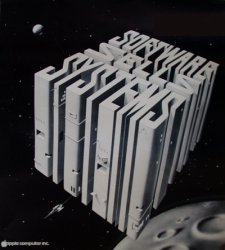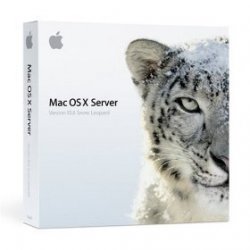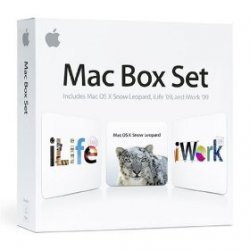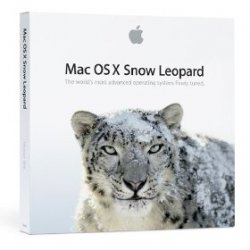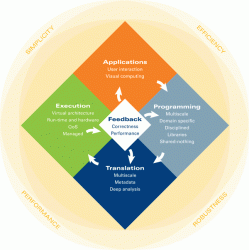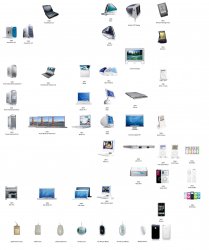


John Siracusa's review is **here**
This thread is intended to be a collation of information regarding Snow Leopard (abbreviated to SL), both normal and also Server editions.
Starting from Known knowns: Apple’s Snow Leopard page
UPDATE
When - August 28th
What
“A Quantum Leap”. No solace required. Billed as changing it’s focus, “taking a break from adding new features” and building on Leopard
- Delivering “a new generation of core software technologies” to
- streamline Mac OS X
- enhance Mac OS X, including improving quality. - Reduce the OS footprint
- Out-of-the-box support for Microsoft Exchange 2007 built into Mail, Address Book, and iCal (using the Exchange Web Serices protocol).
- “Grand Central”
– A set of technologies to improve performance
- Makes “all of OS X multi-core aware”
- Optimises Mac OS X it for “allocating tasks across multiple cores and processors”
- Helps developers, by making it easier for them to create programs that can effectively use the power from multiple cores and processors. - Extension of 64-bit technology in Mac OS
- Allowing up to a theoretical 16TB maximum of RAM (No word on what type) - Quicktime X
- Streamlined platform for modern media and internet.
- Optimised support for modern codecs
- More efficient media playback - Through Safari, delivering fast Javascript (e.g. implementing this through MobileMe)
- OpenCL (Open Computing Language)
- A language to help developers use the power of GPUs (graphics processing units) and redirect it for general purpose computing.
- In other areas, OpenCL is akin to GPGPU.
- Please watch this tutorial series for more! http://www.macresearch.org/opencl_episode1 - ZFS - Not mentioned on the normal SL page, but confirmed for the SL Server edition here
- Read & write support for the 128-bit ZFS file system
- Features such as storage pooling, data redundancy, automatic error correction, dynamic volume expansion, snapshots.
Who
Apple, obviously. Intel. NVidia and more.
Why
To make money, serve the stockholders, and to create useful Apple product - software and hardware.
Basically, Apple has sweetened the pot to get people to move to OS X through the low upgrade price, and new features.
How Much

T&C say only US and Canada
$9.95*for a single user if you buy a Mac between June 8 and September (via Snow Leopard up-to-date program)*
$29 to upgrade from Leopard for a single user.
$49 for a family pack to upgrade Leopard machines
* "Covers product plus shipping and handing fee. U.S. customers add appropriate sales tax."
$9.95 upgrades qualifying Xserves ("MA882LL/A, MB449LL/A. Z0E7, Z0FR, Z0GM") or an Apple Certified Refurbished Xserve from the Apple Online Store on or after June 8, 2009 to Mac OS X Server v10.6 Snow Leopard Unlimited Client for $9.95 plus tax.
UK page here
Happily lower prices than previously thought. I stand corrected, and happy that Daniel here at least this time was wrong. Terms and Conditions apply, Apple reserves the right to change the terms of this offer at any time without notice etc etc.
Amazon is taking pre-orders for Snow Leopard. Upgrade is available for Intel based Macs currently running Leopard. Tiger users can buy a Mac Box Set. From the front page:
- Mac OS X version 10.6 Snow Leopard ($29.00)
- Mac OS X Snow Leopard Family Pack (5-User) ($49.00)
- Mac Box Set - (with Snow Leopard) ($169.00)
- Mac Box Set Family Pack with Snow Leopard (5-User) ($229.00)
- Mac OS X Server version 10.6 Snow Leopard ($499.00)
Note: Purchases through these Amazon links benefit MacRumors financially.
Amazon has also begun offering pre-orders of OS X Snow Leopard family packs, Mac Box Sets bundling Snow Leopard with iLife '09 and iWork '09, and Snow Leopard Server.
For breaking that down, currently we have some main topic areas being
- Level of multi-touch in SL
- Usage of SL as a basis for the OS of future iPhones and other "electronic devices"
- Microsoft Exchange 200 support, and how much other Windows support SL will have
- “Grand Central” dispatch & threads
- how it ties in with Intel and their multiple core chips, and also with multiple processors.
- How it ties in with developing Mac OS X apps, and also iPhone apps - How 64-bit technology and a 16TB maximum (along with the other mentioned factors) will affect computing
- Quicktime X
- Safari - and Javascript - how this will be deployed. Looking at Air, Silverlight and others (e.g. Prism).
- OpenCL
- How it will tie in with SL, and Grand Central, and who Apple goes for to supply these GPU chips/ GPU boards for GPGPUage
- How it will affecting computing, alongside Grand Central
- It's rivals on the scene, and how Intel will play it's part.
There's a list of sources on page 2 (the word limit is biting).
Some guides for Snow Leopard - here
The state of play currently

As wiki on the Tick Tock strategy notes:
Tock - Intel Core microarchitecture of 2006
Tick - Shrink/derivative (i.e. Penryn) 45 nm of 2007
Tock - New Intel microarchitecture (i.e. Nehalem) for 2008
Tick - Shrink/derivative (Westmere) 32 nm for 2009
Tock - Future Intel microarchitecture (i.e. Sandy Bridge) for 2010
So Penryn's successor is expected to be Nehalem. Nehamlem will bring back hyperthreading, which will crop up soon enough. SL will release after Nehalem, and potentially around Westmere, and before Sandy Bridge in 2010.


